1 Terabyte Hitachi Deskstar 7K1000 Review
1 Terabyte Hitachi Deskstar 7K1000
Hitachi raises the bar on hard disk capacity with the world's first one terabyte drive.
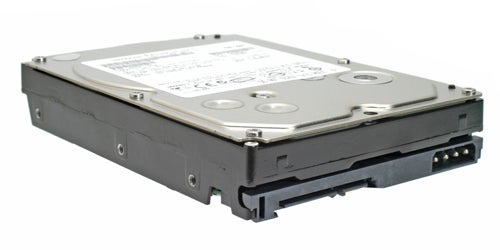
Verdict
Key Specifications
- Review Price: £249.44
It’s inevitable that you will have judged the Deskstar 7K1000 before you even read the first paragraph of this review – either you need a 1000 Gigabyte hard drive or you don’t, there’s not much I can do to convince you either way!
You see, for the average home user, unless you store large amounts of multimedia, either on your local computer or on a Network Attached Storage (NAS) appliance, you will never have a use for a hard drive of such colossal capacity. Even a computer loaded with Windows Vista, a dozen modern games, all the usual web browsers, media players and office productivity suites as well as several years’ worth of documents and images will probably still only be using less than 100GB. Of course storage requirements will always increase but not so fast that the average user will need to be increasing their hard drive capacity by an order of magnitude right now.

However, if like everyone at the TR office you have a large store of multimedia content then you will be all too familiar with the constant quest for more space – especially as everything is moving to high definition.
For instance, on my computer at home I have a 60GB RAID-0 system drive, a 500GB data drive and a 250GB external hard drive, all of which are at least 70 per cent full. Also on our network we have a Buffalo Terastation that houses a RAID 5 array of four 250GB hard drives (giving us an effective 750GB of space) and even that is crammed full. So, the onward march of hard drive capacity is nothing but a welcome movement.
While all the major hard drive manufacturers will no doubt be announcing their own one terabyte hard drives in the not too distant future, it is Hitachi that has managed to hit this milestone first and so it’s that particular drive we have the pleasure of looking at today.
At £249.44, the 7K1000 is nearly £100 more expensive than the next biggest drive available – the 750GB Seagate Barracuda – but this price will no doubt fall rapidly as other manufacturers come out with their own terabyte drives. Also, this is cheaper than the Barracuda was when it first launched nearly a year ago.
Terabyte Hitachi Deskstar 7K1000 hard drive.” width=”300″ height=”286″ class=”align size-medium wp-image-163437″ srcset=”https://www.trustedreviews.com/wp-content/uploads/sites/54/2007/05/4642-IMG4042s-1.jpg 500w, https://www.trustedreviews.com/wp-content/uploads/sites/54/2007/05/4642-IMG4042s-1-300×286.jpg 300w, https://www.trustedreviews.com/wp-content/uploads/sites/54/2007/05/4642-IMG4042s-1-320×305.jpg 320w” sizes=”(max-width: 300px) 100vw, 300px” />
To achieve this massive capacity, Hitachi has moved to a perpendicular recording technology for its hard drives – just as Seagate did with its 750GB drive. Perpendicular recording orientates the magnetic particles, used to store each bit of data, vertically instead of laying them on their side, this makes them narrower, so more bits can be stored on each platter.
It would seem Hitachi’s method of doing this results in similar platter density to Seagate’s method as the 750GB version of the 7K1000 uses four platters just as Seagate’s does. Indeed, to reach the hallowed one terabyte mark, Hitachi has had to squeeze five platters and ten heads into the same 3.5in form factor.
Naturally, you’d expect that extra platter to increase noise, weight, and heat but miraculously the 7K1000 is significantly quieter than the 750GB Barracuda and it weighs only 3g more. It does run a few of degrees hotter but all in all it compares very well with the competition.
Elsewhere, the 7K1000 has all the features you would expect from a modern hard drive; spindle speed is 7,200rpm, the interface is 3Gbps SATA-II, and it supports Native Command Queuing (NCQ). The onboard data buffer is a whopping 32MB and it even has a legacy Molex power connector – something the Seagate doesn’t have – for those of us with ailing power supplies.
As with all hard drives, the 7K1000’s rated capacity isn’t actually the size you’ll get when you start using it and there are two reasons behind this. First, hard drive manufacturers choose to measure one terabyte as 1,000,000,000,000 or 1012 bytes whereas operating systems measure one terabyte as 1,099,511,627,776 or 240 bytes, so the physical space isn’t even there in the first instance. Quite how and why manufacturers get away with this is beyond us but, as it’s something they all do, we won’t hold it against Hitachi. Secondly, the process of formatting a drive for use in a computer uses up some of its capacity, so even more usable space is lost. The upshot of all this is that, after formatting the drive using Microsoft NTFS, the 7K1000 only gives you about 935GB of actual storage.
TB Hitachi Deskstar 7K1000 hard drive circuitry view.” width=”300″ height=”209″ class=”align size-medium wp-image-163442″ srcset=”https://www.trustedreviews.com/wp-content/uploads/sites/54/2007/05/4642-IMG4043s-1.jpg 500w, https://www.trustedreviews.com/wp-content/uploads/sites/54/2007/05/4642-IMG4043s-1-300×209.jpg 300w, https://www.trustedreviews.com/wp-content/uploads/sites/54/2007/05/4642-IMG4043s-1-320×223.jpg 320w” sizes=”(max-width: 300px) 100vw, 300px” />
With a seek time double that of the fastest SATA hard drives, the 7K1000 isn’t going to be competing for any performance crowns in the hard drive world. However, the platter density does mean that sustained read and write speeds are very competitive and writing large files to and from the disk will be nice and speedy.
To test the drive’s speed, we hooked it up to our usual test bed which consists of an Intel 975XBX2 “Bad Axe” motherboard loaded with an Intel Core 2 Duo QX6800 quad core CPU coupled with 2GB of Corsair CMX1024-6400C3 running at 800MHz with latency settings of 3-4-3-9. The system hard drive is a 400GB Seagate Barracuda 7200.8. We added the formatted 7K1000 as a secondary drive then ran HDTune to determine the drive’s raw performance. For comparison I also did the same test using a Seagate 750GB Barracuda 7200.10 as it’s the closest competitor in terms of size.
Both drives show very similar performance characteristics with identical access times and very similar transfer rate curves. The only real difference comes from the extra platter that means the Hitachi can simply read or write more data at any one time.
Now, because the 7K1000 has such fast transfer speeds, we weren’t able to test drive to drive transfers, because our system drive would’ve been a bottleneck. Therefore I tested each drive within itself, i.e. copied files from partition to partition on the same drive. This test gives a good overall impression of the drive’s real world performance with transfer speeds, access times and latency all being given a good work out.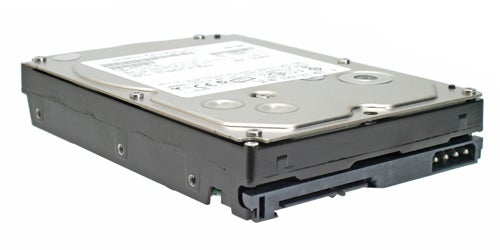
To prepare I partitioned each drive into three 200GB chunks and one partition that used up the rest of the available space. Then I copied a 4.3GB ISO (DVD image) file and a folder containing 1,302 files of varying sizes and types (totalling 627MB) to the first partition. I then timed how long it took to copy the ISO image from the first partition to the first partition, then the first partition to the second partition, then the second partition to the third partition, and so on. I then did the same with the folder of different files.
As would be expected both drives exhibited a pattern of declining performance as the transfers moved towards the inner portions of the disc (the third and fourth partitions) – just as in the HDTune results. However, once again the 7K1000 comfortably took and held the lead from the Seagate drive.
”’Verdict”’
The Hitachi 7K1000 one terabyte hard drive is simply very impressive. Quiet operation, stellar performance, unmatched capacity, and a pretty reasonable price tag make this the best high-capacity hard drive available.
”’1 Terabyte Hitachi Deskstar 7K1000”’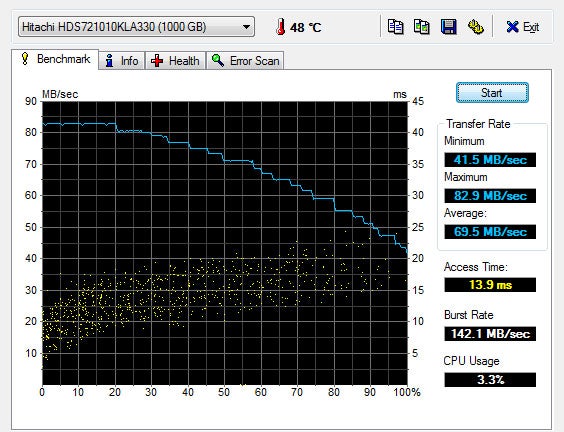
—-
”’750Gb Seagate Barracuda 7200.10”’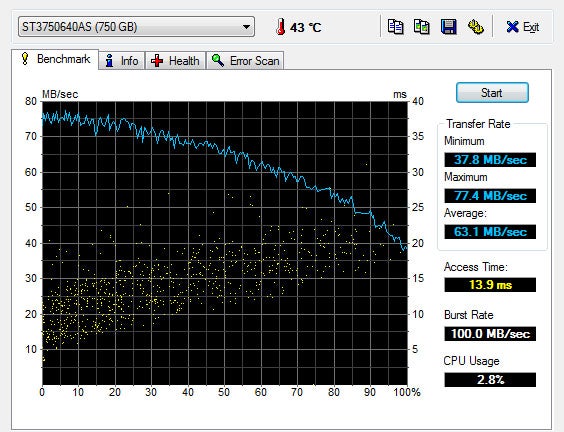
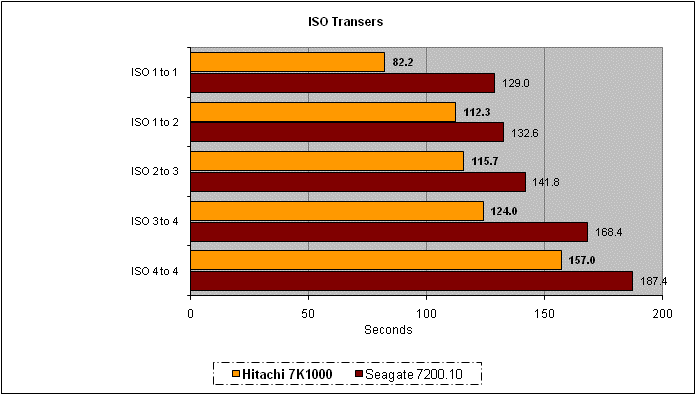
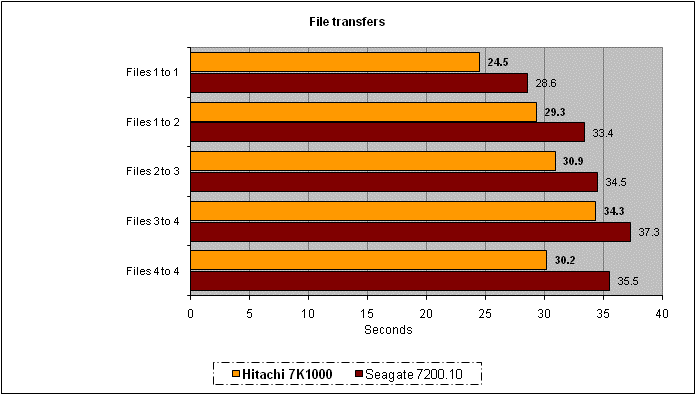
Trusted Score
Score in detail
-
Value 9
-
Features 7

